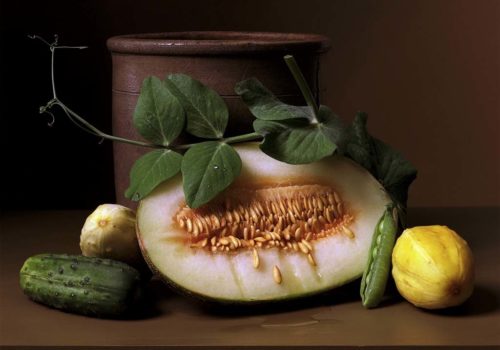We who know most paintings by their photograph are more often than not looking at distortions that arise from the process itself. Flattened as a three dimensional object, the painting becomes a shadow of its former self, the energy that once was live on the canvas now lost on the page. But our eye acclimates, and we read distortions of color and texture and surface with infinite grace, and we have mentally replaced the copy with the original until we come to see it face to face.
Where the tradition of Western painting once sought to become a time immemorial depiction of the transitory nature of life, the camera easily upset this apple cart. By producing a more accurate representation of the thing itself, the camera liberated the painter from reality and allowed them to explore the medium itself. This would begin in the mid-nineteenth century, just as the camera took hold, and painters, informed by this process, began to study the effects of light itself.
But before this, there was one last gasp at a kind of realism that showed the danger of time elapsed. This is most evident in the still lifes of the period, of the faithfully rendered fruit and flowers that sparkle with life and hint at death. These still lifes remind us of the place where Man and Nature meet, as Man carefully culls from the garden to create a bounty upon the table and plate.
During this era worked American painter Raphaelle Peale, who concentrated intently upon the genre to create a distinctive atmosphere that has been described by art historian Alexander Nemerov as eccentric. As Nemerov notes, “Raphaelle’s paintings simulate the artist’s own physical existence projected into the objects of perception,” creating a tangible quality that makes his subjects more life than still.
In response to Peale’s work, Sharon Core has created Early American (Radius Books), a series of photographs faithfully recreating the paintings themselves. Core was interested in the uncanny lifelikeness of Peale’s work, which blended an American austerity with a distinctly non-American style of painting to create a series of paintings that are more of a period than of a place. Core was also interested in the relationship between illusionism, trompe l’oeil, and how photography could be explored through replication of the original still life itself.
As Brian Sholls notes in the book’s introduction, “It took Core long hours to collect the items (both organic and inorganic) necessary to re-create Peale’s compositions. At first she spent time exploring antiques stores, garden centers, and flea markets in New York’s Hudson Valley. However, the age and rarity of what she sought made that work impossible, so she turned to more systematic methods. For dishes and tableware, including a particular kind of Chinese export porcelain so prevalent in Peale’s canvases, she monitored auctions on eBay. For rare and heirloom species of fruit and flowers, such as Anne Arundel melons, she likewise turned to online sources, such as the Thomas Jefferson Center for Historic Plants.”
Working closely to recreate every last detail of the original works, Core has produced a series of photographs at once magnificent, and evocative, provoking questions about the nature of the relationship between the mediums. Artists aim to recreate both their inner and outer world, more often than not producing a dialogue between the two. Where Peale was inspired to use still life to document America’s bounty in the country’s earliest decades, showing us how the newest nation of earth was rapidly modernizing and kept abreast of the developments in Europe, two hundred years later, Core is inspired to reflect on this in the medium that surpassed painting as the most faithful mode of representation.
It is here that Core’s work as a photographer gives us pause, for her dedication to the original work creates a surreal feeling of hyper-realism that is unfamiliar in photography. It is a kind of realism that is about the medium of painting itself, as Core deftly manipulates her camera to record the painterly qualities of light, color, and the invisible brushstroke that makes realist painting so real it’s fake. Looking at Core’s photographs we are reminded of the act of painting itself, and the way the camera can manipulate the surface of the image to create the same feeling on its own terms.
Early American is a treasure trove, a collection of photographs that are both new and old. These images remind us of a way of life so long gone it evokes a powerful response, a kind of nostalgia for a time and a style that is no longer part of our lives. And yet at the same time, Core reminds us that the past is never over, it is part of our lives, forever recreated as we need it to serve us as a means to understanding and experiencing life.
Miss Rosen
















